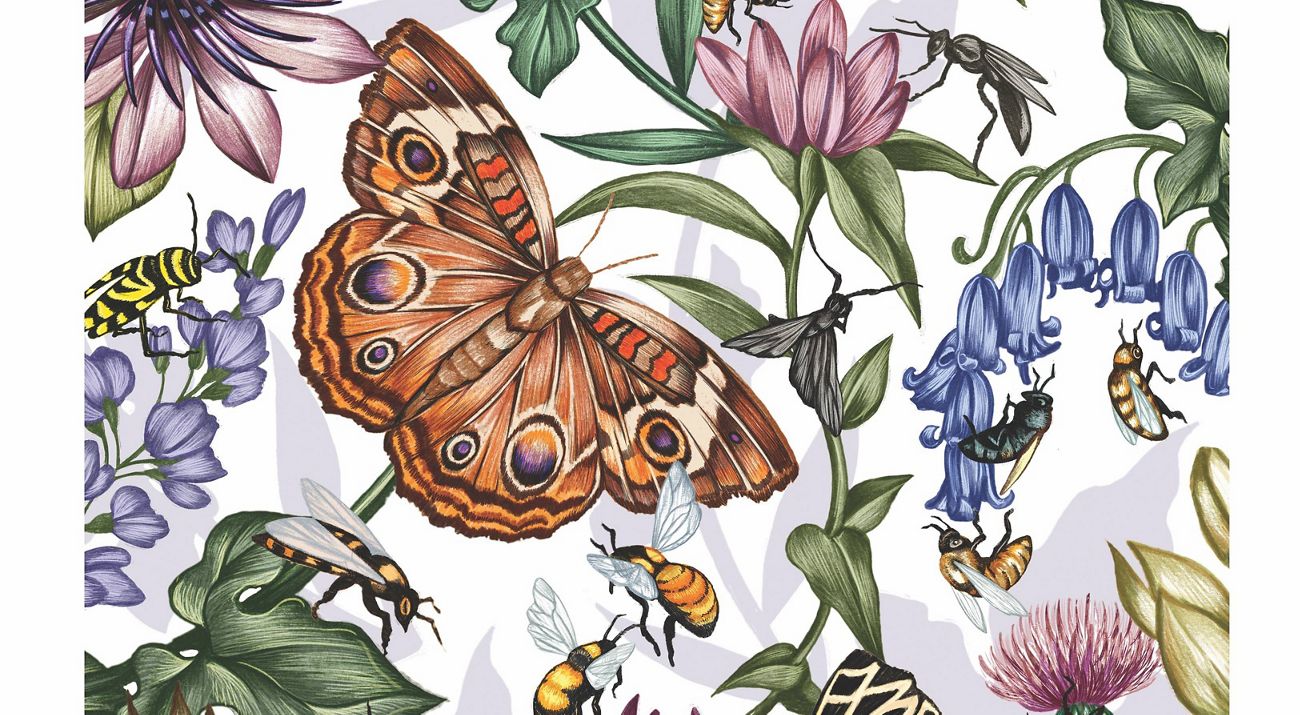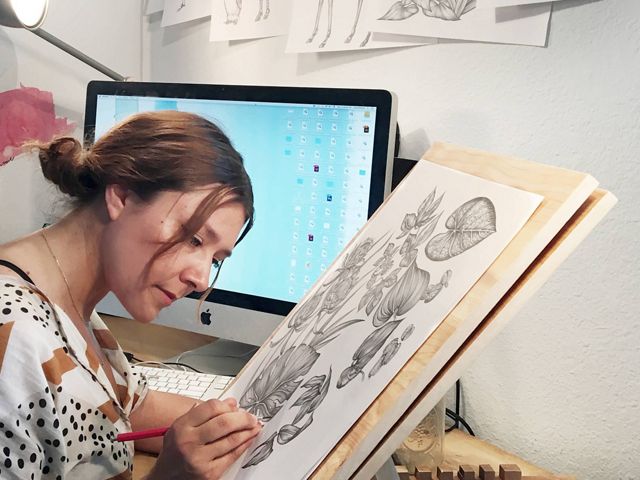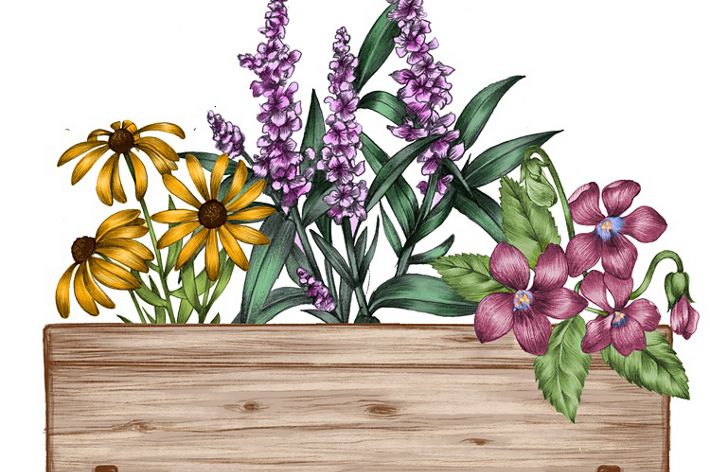
Planting for Pollinators
Native pollinators are facing growing threats. Here are some fun and easy ways you can help them!
Spring 2020

Who Drew These Amazing Illustrations?
Lisel Jane Ashlock is a freelance illustrator working in California. She originally created the illustrations on this page and on Creating a Pollinator Paradise for the article "Planting for Pollinators," which appeared in the Spring 2020 issue of Nature Conservancy magazine (subscribe here). Watch the video below to see her at work.
A normal November in the coastal city of Pacific Grove, California, will offer a fantasia of twinkling orange and black wings, as thousands of monarch butterflies descend on pine, cypress and eucalyptus groves where they cluster together to spend the winter.
But fall 2018 was different. Emma Pelton, a biologist with the Xerces Society for Invertebrate Conservation, went to Pacific Grove and nearby Pismo Beach for the organization’s annual Western Monarch Thanksgiving Count expecting some semblance of the “completely magical” scene she had observed in previous years. What she found instead was a pale shadow of past counts, with just a few scattered clumps of butterflies on branches.
It was the same up and down the coast: At hundreds of sites, from Mendocino County to Baja California, volunteers counted only about 30,000 Western monarchs—86% fewer than the number of butterflies the year before.
Stay in the Loop
Get conservation stories, news and local opportunities from where you live.
Such a large one-year drop is not necessarily unusual, Pelton says, but as part of a longer-term decline in the butterfly’s population, it is worrying. The current population is estimated to be less than 1% of its early 1980s level, she says. “We’re pretty concerned that this is the lowest-ever count we’ve had. Researchers have put the threshold—below which the population could collapse—at about this number. So the hypothesis that this is the tipping point is going to be put to the test.”
There’s more at stake than the loss of a flashy annual spectacle and one of nature’s most perplexing migrations (monarchs travel thousands of miles over multiple generations to reach their migratory destinations). Some researchers are concerned that recent declines in some butterfly species could be an indicator that more pollinators are struggling. And if pollinators are struggling, so too will the flowering plants that depend on them to spread their pollen.
The plight of the European honeybee, which was imported from Europe in the 17th century and is widely used for pollination services in commercial agriculture, has gotten a lot of attention. But fewer people are aware that native pollinators—including butterflies, bees, hummingbirds, moths and bats—also pollinate food crops, as well as more than 75% of the world’s flowering plants. And, like monarchs and honeybees, many of these pollinators are in trouble.
Some pollinators, such as the endangered rusty-patched bumble bee, are generalists, able to pollinate a variety of plant species. Other pairs of plants and animals have evolved into highly specialized, exclusive partnerships. For instance, fig trees can be pollinated only by a single species of wasp. Across the board, the fates of pollinators and their host plants are intertwined. And for many native pollinators, the plants they rely on are native plants that face their own threats from invasive species, development and a changing climate.
Quote
The fates of pollinators and their host plants are intertwined. For many native pollinators, the plants they rely on face their own threats.
Threats to Pollinators
The threats to pollinators are as numerous and varied as the species themselves—and other factors may yet be discovered—but scientists point to a few major contributors: insecticides; invasive species; parasites and diseases; and climate change.
“A lot of these pollinators have evolved to emerge exactly when their plants are flowering,” says Deborah Landau, a conservation scientist for The Nature Conservancy in Maryland. But climate change is playing havoc with the timing of many natural events. “If a flower blooms too early or an insect hatches from its egg too early, they could completely miss each other.”
One of the biggest contributors, and the one TNC is most directly addressing, is the disappearance and fragmentation of native plant habitat. Every square mile of open land turned to shopping centers or highways is the pollinator equivalent of leveling Manhattan.
And for pollinators that migrate, like monarch butterflies and many species of hummingbird, habitat loss is occurring all along their range—so a California housing tract built with lumber harvested from Mexican forests may be doing double the damage.
The loss of pollinators is part of a larger pattern that conservationists and scientists are grappling with. Recent studies in Europe reporting huge decreases in the volume of insects being caught in traps have prompted headlines warning of an “insect apocalypse.” While it’s unclear if these results are a bellwether of global population collapse, conservationists like Landau find them concerning.
The very abundance of insects makes it impossible to quantify their losses, Landau says. “There’s so little knowledge not just of the amount of species, but the amount of individuals, that it’s hard to categorize.” It’s estimated there are millions of species that have yet to be discovered, and some have almost certainly gone extinct without ever being known to humans.
How You Can Help Pollinators
The good news is that even small actions by individuals can help. A key to making native pollinators more abundant is increasing native plant abundance.
Urban apartment dwellers can get involved with community gardens or put out a window box with native flowers. (Visit the Ladybird Johnson Wildflower Center at wildflower.org and choose the “Native Plants” tab to find flowers that will work for your area.) And, for those who have a lawn, something as simple as tolerating dandelions provides an early spring pollinator meal before other flowers appear.
Even better: Replace at least a patch of that manicured grass with a native garden. Between the chemicals, water needs, lawn-mower pollution and lack of flowering plants, Landau says, “lawns are just ecological disasters.”
Whether you live in a city high-rise, a suburban cul-de-sac or on a farm, you can create an oasis of pollinator habitat. “Insects can fly,” points out Megan Whatton, a project director with TNC in Virginia, “so even if you’re on the 10th floor, if you plant it, they will come.”
A few years ago, Whatton was buying her first home when she started working on The Habitat Network, a partnership between TNC and the Cornell Lab of Ornithology that allowed people to map the pollinator habitat in their communities. Figuring she should practice what she preached, Whatton and her husband planted a native garden of their own. “It has been so much fun,” she says, to watch what drops by for a meal—from monarch caterpillars munching on milkweed to hummingbirds sipping nectar.
On a larger scale, conserving and connecting swaths of pollinator habitat are built into much of TNC’s existing work. In Maryland, Deborah Landau has overseen controlled burns on Conservancy land. Fire has always been part of many ecosystems’ natural cycles, and more than a century of fire-suppression practices have changed the makeup of forests. “When we bring fire back to the landscape,” Landau says, “we get these resurgences in native plants.”
A number of local and regional TNC offices are also involved in pollinator-specific efforts. In Kentucky, TNC has planted wildflowers on its Mantle Rock Nature Preserve. A study in 2016 confirmed that 30 years of prairie restoration and the recent reintroduction of American bison at the Conservancy’s Nachusa Grasslands in Illinois have brought a diverse and robust population of native bees back to the landscape. In Oklahoma, TNC is one of more than 40 organizations taking part in Okies for Monarchs, with the goal of developing and implementing a statewide monarch conservation plan. And TNC has partnered with organizations in other states to protect threatened butterflies, such as the Karner blue in the Northeast and the Dakota skipper in the prairie states.
An intriguing idea, popular with speculative fiction writers, is “the butterfly effect”—where any tiny action unleashes a chain of events that reverberate in far-off, unexpected ways. The flapping of a butterfly’s wings, for instance, might lead to a tornado, weeks later. It sounds far-fetched, but it speaks to the central truth that every living thing has an important place in our planet’s web of life.
So what would happen if there were no more butterflies? With the cumulative effects of all of our actions, tiny or great, we can hope that we’ll never find out. “Every little bit that you can do really helps,” says Landau.






